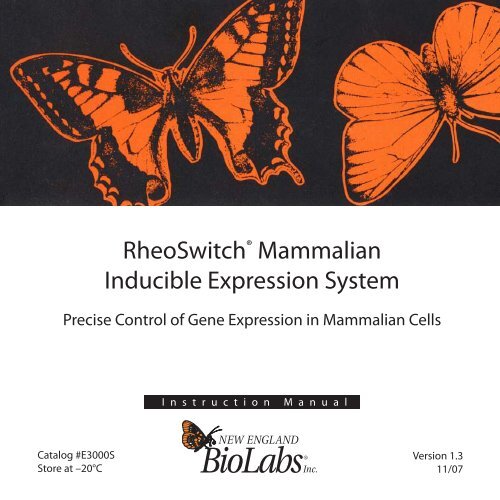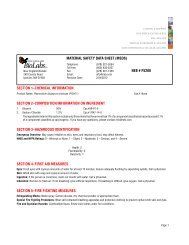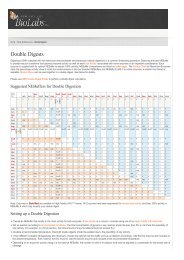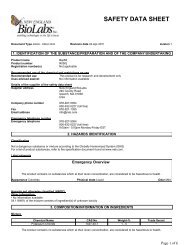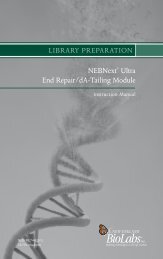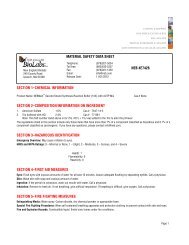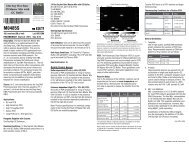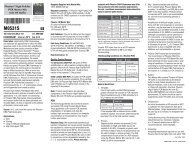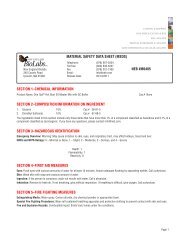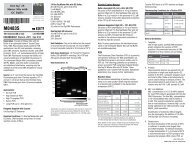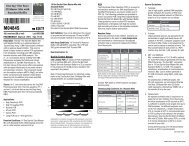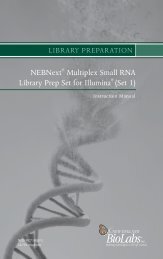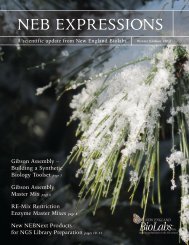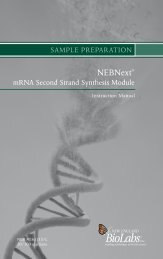Manual - New England Biolabs
Manual - New England Biolabs
Manual - New England Biolabs
Create successful ePaper yourself
Turn your PDF publications into a flip-book with our unique Google optimized e-Paper software.
Catalog #E3000S<br />
Store at –20°C<br />
RheoSwitch ® Mammalian<br />
Inducible Expression System<br />
Precise Control of Gene Expression in Mammalian Cells<br />
I n s t r u c t i o n M a n u a l<br />
Version 1.3<br />
11/07
Table of Contents:<br />
Supplied Components . . . . . . . . . . . . . . . . . . . . . . . . . . . . . . . . . . . . . . . . . . . . . . . . . . . . . . . . 2<br />
Introduction . . . . . . . . . . . . . . . . . . . . . . . . . . . . . . . . . . . . . . . . . . . . . . . . . . . . . . . . . . . . . . . . . . 4<br />
Background . . . . . . . . . . . . . . . . . . . . . . . . . . . . . . . . . . . . . . . . . . . . . . . . . . . . . . . . . . . . . . . . . . . 5<br />
Experimental Outline . . . . . . . . . . . . . . . . . . . . . . . . . . . . . . . . . . . . . . . . . . . . . . . . . . . . . . . . 13<br />
Example Protocol . . . . . . . . . . . . . . . . . . . . . . . . . . . . . . . . . . . . . . . . . . . . . . . . . . . . . . . . . . . . 15<br />
Appendix<br />
pNEBR-X1Hygro Plasmid Map and MCS . . . . . . . . . . . . . . . . . . . . . . . . . . . . . . . . . . . . . 17<br />
pNEBR-R1 Plasmid Map. . . . . . . . . . . . . . . . . . . . . . . . . . . . . . . . . . . . . . . . . . . . . . . . . . . . . 19<br />
References . . . . . . . . . . . . . . . . . . . . . . . . . . . . . . . . . . . . . . . . . . . . . . . . . . . . . . . . . . . . . . . . . . . 20<br />
Kit Components Sold Separately/Companion Products . . . . . . . . . . . . . . . . . . . . . . . . 21<br />
Licensing Information . . . . . . . . . . . . . . . . . . . . . . . . . . . . . . . . . . . . . . . . . . . . . . . . . . . . . . . . 22<br />
RheoSwitch ® is a registered trademark of RheoGene, Inc.<br />
TransPass is a trademark of <strong>New</strong> <strong>England</strong> <strong>Biolabs</strong>, Inc.<br />
1
2<br />
Supplied Components:<br />
The RheoSwitch ® Mammalian Inducible Expression System contains plasmids<br />
and ligand inducer necessary to express genes in mammalian tissue culture.<br />
Store at –20°C.<br />
Vectors:<br />
pNEBR-R1 Regulator Plasmid (500 µg/ml) 20 µg<br />
Expresses an engineered nuclear receptor heterodimer, consisting of two<br />
proteins, RheoReceptor-1 and RheoActivator. The two proteins constitute the<br />
holoreceptor and regulate transcription of genes cloned into the expression<br />
vector, pNEBR-X1. The two proteins are expressed from the constitutive ubiquitin<br />
UbC and UbB promoters, respectively. The plasmid also contains the neomycin<br />
resistance gene under control of the SV40 early promoter for the generation of<br />
stable cell lines.<br />
pNEBR-X1Hygro Vector (500 µg/ml) 20 µg<br />
Used to clone the gene of interest. The plasmid, has five copies of the GAL4<br />
response element (5XRE) upstream of a TATA box and a short leader sequence<br />
followed by multiple cloning sites and an SV40 polyA signal. The plasmid also<br />
contains the hygromycin resistance gene under control of the thymidine kinase<br />
promoter for generation of stable cell lines.<br />
pNEBR-X1GLuc Control Plasmid (500 µg/ml) 20 µg<br />
Used as a positive control for expression analysis. This plasmid expresses<br />
secreted Gaussia luciferase.
Inducer:<br />
RheoSwitch ® Ligand RSL1 (5 mM in DMSO) 50 µl<br />
Sequencing Primer:<br />
RheoSwitch R-X1 Sequencing Primer<br />
5´ (GGGTATATAATGGGGGC) 3´ 200 pmol<br />
This primer can be used to confirm correct insertion of gene to be expressed in<br />
pNEBR-X1. Supplied as a lyophilized triethylammonium salt.<br />
Luciferase Assay Reagents:<br />
GLuc Substrate (100X) 50 µl<br />
GLuc Assay Buffer 5 ml<br />
3
4<br />
Introduction:<br />
The RheoSwitch ® Mammalian Inducible Expression System permits maximum control<br />
of gene expression in mammalian cells. Analogous to the operation of a rheostat, the<br />
RheoSwitch technology allows induction and adjustable control of gene expression.<br />
This precise regulation of gene expression is achieved through the highly specific<br />
interaction of a synthetic inducer, RheoSwitch Ligand RSL1, and a chimeric bipartite<br />
nuclear receptor. This receptor is activated in the presence of RSL1 ligand, and the<br />
level of gene expression can be regulated by adjusting the concentration of RSL1<br />
ligand in the tissue culture media.<br />
The RheoSwitch technology offers several advantages over other inducible systems.<br />
Its precise control is unrivaled among mammalian expression systems, giving negligible<br />
levels of basal expression in the absence of inducer and greater than 10,000 fold<br />
induction when RSL1 ligand is present. Unlike other systems, which rely on steroids<br />
or other drugs, the synthetic ligand RSL1 shows no pleiotropic effects in mammalian<br />
cells and exhibits no cross talk with endogenous transcription factors. In addition, the<br />
RheoSwitch System has no special culture media requirements.<br />
Applications:<br />
• Inducible protein expression<br />
• Expression of toxic genes<br />
• Overexpression/mutant rescue studies<br />
Features:<br />
• Precise regulation of expression levels<br />
• Negligible basal expression<br />
• Synthetic inducer and engineered receptor eliminate non-specific side effects
Background:<br />
The RheoSwitch System represents the next generation of inducible gene expression<br />
systems for mammalian cells. It is composed of an engineered nuclear receptor and<br />
a synthetic ligand inducer that is highly specific. The system is built on a two-hybrid<br />
switch format that activates transcription in the presence of inducer and represses<br />
gene expression in its absence (1,2,3 and unpublished observations). The synthetic<br />
receptor is composed of two proteins, RheoReceptor-1 and RheoActivator, that dimerize<br />
to make a holoreceptor. Both are expressed from strong constitutive promoters on<br />
plasmid pNEBR-R1. The RheoReceptor-1 protein is a highly engineered ligand-binding<br />
domain (LBD) of an insect EcR nuclear receptor fused to the yeast GAL4 DNA<br />
binding domain. The RheoActivator protein is an insect/mammalian RXR hybrid LBD<br />
fused to the viral activation domain VP16. The gene to be expressed is cloned into<br />
the pNEBR-X1 plasmid under control of five tandem repeats of the GAL4 response<br />
element (5XRE). In the absence of RSL1 ligand, the receptor represses transcription<br />
by binding to the GAL4 elements in a transcriptionally inactive conformation.<br />
Upon induction, the RSL1 ligand tightly binds and changes the conformation of the<br />
RheoReceptor-1 protein which stabilizes the holoreceptor heterodimer on the 5XRE.<br />
The activated holoreceptor and the VP16 activation domain bind and recruit to the<br />
promoter transcriptional coactivators along with basal machinery, resulting in a highly<br />
induced transcriptional state (Figure 2).<br />
This high induction of transcription coupled with extremely low basal expression<br />
results in extremely high induction levels (greater than 10,000 fold induction), with a<br />
degree of control that is superior to other systems.<br />
RSL1 ligand induces transcription over a broad range of concentrations from<br />
picomolar to micromolar. As illustrated in Figure 3, Gaussia Luciferase activity<br />
increases in an almost linear fashion with increasing amounts of RSL1. Likewise,<br />
increasing amounts of protein are observed, via immunoblot assay, with increasing<br />
5
6<br />
amounts of RSL1 (Figure 4). Even with a longer exposure, no protein is observed<br />
in non-induced cells (Figure 4, Lane 5), further demonstrating the degree of control<br />
of over expression. Induced expression can be seen in as little as 1 hour, reaching<br />
a maximum level between 48 and 72 hours (Figure 5). The RheoSwitch System is<br />
very responsive to RSL1 and its removal from the medium will rapidly turn off gene<br />
expression (Figure 6).<br />
RSL1 ligand is a synthetic diacylhydrazine, [N-(2-ethyl-3-methoxybenzoyl)-N´-<br />
(3,5-dimethylbenzoyl)-N´-tert-butylhydrazine] (Figure 1) (4). It is one of a family of<br />
compounds that have been found to act as non-steroidal ecdysone agonists and can<br />
function as gene inducers (4,5). RSL1 binds tightly and selectively to RheoReceptor-1,<br />
altering its conformation so that it releases bound negative regulatory cofactors and<br />
stabilizes the RheoReceptor/RheoActivator heterodimer. RSL1 is not a steroid—it is<br />
invisible to mammalian nuclear receptors and has been shown to be inert within all<br />
cell lines tested to date. The result is an inducible system that specifically controls the<br />
gene of interest without unwanted effects on the host cells.<br />
O<br />
O<br />
N<br />
H<br />
N<br />
Figure 1: Chemical structure of RheoSwitch<br />
Ligand RSL1 (MW=382.5 daltons).<br />
O
pNEBR-R1<br />
RheoReceptor-1 P1 P2 RheoActivator<br />
OFF ON<br />
pNEBR-X1Hygro<br />
5X RE<br />
Gene of Interest<br />
pNEBR-R1<br />
RheoReceptor-1 P1 P2 RheoActivator<br />
pNEBR-X1Hygro<br />
5X RE<br />
Basal<br />
Transcription<br />
Complex<br />
Gene of Interest<br />
Figure 2: Transcriptional control using the RheoSwitch System. "OFF" state: In the<br />
absence of RSL1 ligand, the RheoReceptor and RheoActivator proteins exist in an inactive<br />
conformation and transcription is kept off. "ON" State: In the presence of RSL1 ligand, the<br />
two proteins stably dimerize and bind to the response element of pNEBR-X1Hygro in an<br />
active conformation and transcription is turned on.<br />
RSL1<br />
7
8<br />
Luciferase Activity (RLU)<br />
90,000 45,000<br />
80,000<br />
70,000<br />
60,000<br />
50,000<br />
40,000<br />
30,000<br />
20,000<br />
10,000<br />
0<br />
0 800 pM 4 nM 20 nM 100 nM 500 nM<br />
RSL1 Concentration<br />
40,000<br />
35,000<br />
30,000<br />
25,000<br />
20,000<br />
15,000<br />
10,000<br />
5,000<br />
Figure 3: Luciferase expression in response to increasing RSL1 concentrations. NIH 3T3<br />
cells co-transfected with pNEBR-R1 and pNEBR-X1 expressing firefly luciferase were<br />
induced with the indicated RSL1 concentrations. Expression was measured 48 hours postinduction.<br />
0<br />
Fold Induction
62<br />
47.5<br />
32.5<br />
25<br />
16.5<br />
A B C<br />
10 50 100 500 0<br />
nM RSL1<br />
62<br />
47.5<br />
32.5<br />
25<br />
16.5<br />
10 50 100 500 0 10 50 100 500 0<br />
nM RSL1<br />
Figure 4: NIH 3T3 (A) and RheoSwitch HEK293-A7 (B) (NEB #C2003) cells were transfected<br />
with pNEBR-X1Hygro encoding a HA-tagged protein using TransPass D2 (NEB #M2554).<br />
NIH 3T3 cells were also co-transfected with pNEBR-R1. RSL1 was added to transfected cells<br />
16 hours later, and cells were harvested 24 hours after induction (Note: DMSO is added as a<br />
control for 0 nM RSL1). Harvested cells were lysed, and equivalent amounts of protein<br />
(as determined by Coomassie Stain) were electrophoresed and transferred to nitrocellulose.<br />
An immunoblot assay was performed on the filter using anti-HA as primary antibody and<br />
detected using anti-mouse secondary antibody and reagents. A longer exposure of the<br />
HEK293-A7 immunoblot is shown (C) to illustrate that no protein is detected in the<br />
absence of RSL1.<br />
9
Luciferase Activity (RLU)<br />
10<br />
100,000<br />
10,000<br />
1,000<br />
100<br />
10<br />
1<br />
RSL1 (500 nM)<br />
DMSO<br />
0 4 8 12 16 20 24<br />
Time Post Induction (Hours)<br />
Figure 5: Induction time course. NIH 3T3 cells co-transfected with pNEBR-R1 and pNEBR-<br />
X1GLuc control plasmid were induced with RSL1. Gaussia luciferase activity was assayed<br />
between 1 and 24 hours post-induction.
Luciferase Activity (RLU)<br />
25,000<br />
20,000<br />
15,000<br />
10,000<br />
5,000<br />
RSL1<br />
Addition<br />
RSL1 (500 nM)<br />
DMSO Control<br />
RSL1<br />
Removal<br />
RSL1<br />
Addition<br />
RSL1<br />
Removal<br />
0<br />
0 12 24 36 48<br />
Hours<br />
60 72 84 96<br />
Figure 6: Rapid ON:OFF switch response to two cycles of addition and removal of RSL1.<br />
NIH 3T3 cells were co-transfected with pNEBR-R1 and pNEBR-X1 expressing a destabilized<br />
firefly luciferase and induced with RSL1 followed by removal of RSL1 at 24 hours. A second<br />
cycle of addition/removal of RSL1 results in a new ON:OFF switch response. To remove RSL1<br />
and turn off expression, cells were washed and RSL1-free media was added at the times<br />
indicated. The blue line represents induced expression. The red line represents uninduced<br />
expression.<br />
11
12<br />
Gaussia Luciferase (GLuc) Control Reporter<br />
The RheoSwitch Mammalian Inducible Expression System includes a control reporter<br />
plasmid (pNEBR-X1GLuc) encoding a secreted luciferase. GLuc is a new luciferase<br />
from the marine copepod Gaussia princeps (6). This luciferase, which does not<br />
require ATP, catalyzes the oxidation of the substrate coelenterazine in a reaction that<br />
produces light (470 nm), and has considerable advantages over other luminescent<br />
reporter genes.<br />
Features of GLuc Control Reporter:<br />
• It possesses a natural secretory signal and upon expression is secreted<br />
in the cell culture medium facilitating assays.<br />
• Produces 1,000 fold higher light intensity than Renilla or firefly luciferases.<br />
• Multiple samples can be assayed from the same transfected cells, for example, at<br />
different time points.<br />
• The sequence has been “codon-optimized” for expression in mammalian cells.<br />
• The secreted protein is very stable and has extremely high activity in light<br />
production allowing for very sensitive assays.
Experimental Outline:<br />
Expressing your gene of interest with the RheoSwitch System is accomplished in the<br />
following steps:<br />
• Clone gene of interest into the pNEBR-X1Hygro Vector.<br />
• Perform transient transfection and test induction of cloned gene.<br />
• Establish a stable cell line expressing the RheoSwitch Receptor.<br />
• Introduce cloned gene into the RheoSwitch Receptor stable cell line.<br />
1. Clone gene of interest into the pNEBR-X1Hygro Vector:<br />
Clone your gene of interest into pNEBR-X1Hygro using any restriction site in the<br />
multiple cloning site (MCS) (Figure 6). The gene sequence must have its own functional<br />
ATG initiation and termination (stop) codons. Sequence at the 5´ junction of the<br />
cloned gene can be confirmed using primer NEB #S1280 (included in the kit) and at<br />
the 3´ end with NEB #S1272.<br />
2. Perform transient transfection and test induction of cloned gene:<br />
Once the gene of interest has been cloned, test its expression in the desired cell line<br />
by co-transfecting with the RheoSwitch Receptor expressing plasmid, pNEBR-R1. Culture<br />
conditions and transfection protocols will depend on the particular cell line used.<br />
We recommend our TransPass D1 (NEB #M2553) or TransPass D2 (NEB #M2554)<br />
transfection reagents; see for protocols and additional information. A<br />
molar ratio of receptor plasmid to expression plasmid between 1:2 and 1:8 is recommended.<br />
The supplied pNEBR-X1GLuc can be used as a positive control.<br />
13
14<br />
To induce expression, RSL1 ligand is added to the transfected cells. RSL1 ligand can<br />
induce gene expression over a broad range of concentrations (Figure 3). Use a final<br />
concentration of 500 nM for full induction. Cells can be assayed for expression 24<br />
hours post induction. Maximum fold induction depends on cell type and transfection<br />
efficiency. See the "Example Protocol" for transient transfection and induction in<br />
NIH 3T3 cells.<br />
3. Establish a stable cell line expressing the RheoSwitch Receptor:<br />
The neomycin resistance gene in pNEBR-R1 can be used to construct stable cell lines<br />
expressing the RheoReceptor and RheoActivator proteins. After transfection, cells<br />
are selected via their ability to grow in media containing the antibiotic G418 using<br />
standard techniques. G418-resistant clones can be screened for RheoSwitch function<br />
using transient transfection of pNEBR-X1GLuc. Screen multiple clones and select<br />
those with high RSL1 induction ratios. For a detailed protocol see:<br />
Current Protocols in Molecular Biology, Chapter 16, Protein Expression, Section III,<br />
Expression in Mammalian cells.<br />
4. Introduce the cloned gene into the RheoSwitch Receptor stable cell line:<br />
The cloned gene in pNEBR-X1Hygro can be introduced by transient transfection in<br />
the stable cell line expressing the RheoSwitch Receptor and induced as described in<br />
step 2. The hygromycin resistance gene in pNEBR-X1Hygro can be used to construct<br />
a stable line expressing the cloned gene. After transfection, cells are selected via their<br />
ability to grow on media containing hygromycin using standard techniques and assayed<br />
for expression of the cloned gene.
Example Protocol:<br />
Transient transfection and induction in NIH 3T3 cells using Gaussia luciferase<br />
control reporter plasmid, pNEBR-X1GLuc:<br />
This protocol is optimized for transfection with NEB's TransPass D2 Transfection<br />
Reagent (NEB #M2554S). If a different reagent is used, modify protocol accordingly.<br />
Day 1:<br />
Plate NIH 3T3 cells in a 24 well plate. Seed 2.5 x 104 cells per well in 0.5 ml DMEM<br />
containing 5% FBS to achieve approximately 50–70% confluence.<br />
Day 2:<br />
The following protocol is given for transfecting 6 wells. The transfection mixture must<br />
be prepared in serum-free medium. However, cells may be transfected in the presence<br />
of up to 5% serum.<br />
1. Prepare a plasmid master mix by adding 600 ng pNEBR-R1 (100 ng/well) and<br />
2.4 µg pNEBR-X1GLuc (400 ng/well) to 0.6 ml serum-free DMEM.<br />
2. Add 9 µl of TransPass D2 Transfection Reagent to the plasmid master mix and<br />
mix gently. Incubate the transfection mixture at room temperature for 20 to 30<br />
minutes.<br />
3. Mix gently and pipet 100 µl of transfection mixture into each of the 6 wells.<br />
Gently rock the plate and return to incubator for at least 1 hour. There is no need<br />
to remove the transfection mixture.<br />
15
16<br />
4. Add RSL1 ligand to a final concentration of 500 nM to three wells and an equivalent<br />
amount of DMSO to the remaining wells as a control. RSL1 can be added to<br />
cells by one of two methods: 1) RSL1, diluted in DMSO, can be added directly to<br />
each well; or 2) Culture medium can be replaced with fresh medium containing<br />
500 nM RSL1.<br />
Notes: a) DMSO concentration should not exceed 0.1 % (v/v) per well. b) RSL1 is not<br />
soluble in culture media at concentrations higher than 10 µM. c) Level of expression<br />
can be adjusted by varying the final RSL1 concentration.<br />
5. Collect at least 20 µl of cell culture supernatant from each well 4–24 hours postinduction<br />
for luciferase assay. Samples may be stored at –20°C without loss of<br />
activity.<br />
Gaussia luciferase assay:<br />
i. Prepare assay working solution by diluting GLuc Substrate 100-fold in GLuc<br />
Assay Buffer. 50 µl of working solution is required for each assay.<br />
ii. Pipet 20 µl of each culture supernatant into a microtiter plate well or sample tube<br />
as appropriate for luminometer being used.<br />
iii. Add 50 µl of assay working solution to the sample and promptly measure the<br />
luminescence. Integrate for 5–10 seconds.
Appendix:<br />
A.<br />
Pci I 5142<br />
BsaA I 4158<br />
ori<br />
BstB I 3808<br />
Sac I 5883<br />
Aat II - Zra I 3644<br />
PshA I 3640<br />
Pvu II 6153<br />
5XRE<br />
MCS<br />
BfuA I - BspM I 3355<br />
pNEBRX1-Hygro<br />
6268 bp<br />
Hyg R<br />
PflM I 155<br />
Bsg I 389<br />
polyA SV40<br />
Sac II 2890<br />
BsaB I 615<br />
Bcg I 1245<br />
Sap I 2071<br />
PpuM I 2348<br />
Xcm I 2365<br />
Figure 6A: pNEBR-X1Hygro plasmid map. Used to clone the gene of interest, it has five<br />
copies of the GAL4 response element (5XRE) upstream of a TATA box and a short leader<br />
sequence followed by multiple cloning sites and an SV40 polyA signal. Only unique restric-<br />
5XRE<br />
TATA box<br />
tion enzyme sites are shown.<br />
...CTCCGAGCGGAGTACTGTCCTCCGAGCGGAGACTCTAGAGGGTATATAATGGGGGCCGTCAGCT<br />
. . . .<br />
RheoSwitch<br />
.<br />
5820 5840<br />
predicted<br />
R-X1 primer (#S1280S)<br />
transcription<br />
start<br />
Ap R<br />
17
18<br />
B.<br />
PshA I 3640<br />
BfuA I - BspM I 3355<br />
Sac II 2890<br />
5XRE<br />
TATA box<br />
...CTCCGAGCGGAGTACTGTCCTCCGAGCGGAGACTCTAGAGGGTATATAATGGGGGCCGTCAGCT<br />
. . . .<br />
RheoSwitch<br />
.<br />
5820 5840<br />
predicted<br />
R-X1 primer (#S1280S)<br />
transcription<br />
start<br />
SacI ApaI NarI HindIII EcoRV<br />
ACTACCAGAGCTCATGGGCCCGTGCAATTGAAGCCGGCTGGCGCCAAGCTTCTCTGCAGGATAT<br />
. . . . . .<br />
5880 5900 5920<br />
XhoI BssHII<br />
BamHI PacI FseI PspXI NotI NheI AscI<br />
CTGGATCCACGAATTCTTAATTAAGGCCGGCCTCGAGCGGCCGCTAGCGATCGCGGCGCGCCAC<br />
. . . . . . .<br />
5940 5960 5980 6000<br />
StuI T7 minimal primer<br />
BsrGI SphI SalI<br />
(#S1272S)<br />
GCGTCTCCGGATGTACAGGCATGCGTCGACCCTCTAGTCAAGGCCTATAGTGAGTCGTATTACG...<br />
. . . . . .<br />
6020 6040 6060<br />
Figure 6B: pNEBR-X1Hygro multiple cloning sites (MCS). To minimize uninduced expression,<br />
a short sequence containing the TATA box separates the end of the 5XRE from the<br />
predicted transcription start. Only unique restriction enzyme sites are shown.
Ale I 8125<br />
BsiW I 8109<br />
Ahd I 9421<br />
Neo R<br />
Xmn I 10021<br />
Sca I 9904<br />
ori<br />
polyA<br />
P SV40early<br />
Ap R<br />
polyASV40late<br />
R heoA ctivator<br />
pNEBR-R1<br />
10338 bp<br />
polyA<br />
SnaB I 655<br />
TK<br />
RheoReceptor<br />
EcoR V 43<br />
Asc I 4327<br />
Figure 7: pNEBR-R1 plasmid map. Expresses an engineered nuclear receptor heterodimer,<br />
consisting of two proteins, RheoReceptor-1, and RheoActivator. The two proteins constitute<br />
the holoreceptor and regulate transcription of genes cloned into the expression vector,<br />
pNEBR-X1. The two proteins are expressed from the constitutive UbC and UbB promoters,<br />
respectively. The plasmid also contains the neomycin resistance gene under control of the<br />
SV40 early promoter for the generation of stable cell lines.<br />
P UbC<br />
P UbB<br />
19
20<br />
References:<br />
1. Karzenowski, D., Potter, D.W., and Padidam, M. (2005) BioTechniques. 39, 191-196.<br />
2. Dai, X., Willis, L.G., Palli, S.R., and Theilmann, D.A. (2005) Protein Expr. Purif. 42, 236-245.<br />
3. Palli, S.R., Kapitskaya, M.Z., Kumar, M.B. and Cress, D.E. (2003) Eur. J. Biochem. 270, 1308–1315.<br />
4. Dhadialla, T.S., Carlson, G.R. and Le, D.P. (1998) Annu. Rev. Entomol. 43, 545–569.<br />
5. Kumar, M.B., Potter, D.W., Hormann, R.E., Edwards, A., Tice, C.M., Smith, H.C., Dipietro, M.A.,<br />
Polley, M., Lawless, M., Wolohan, P.R., Kethidi, D.R. and Palli, S.R. (2004). J. Biol. Chem. 279,<br />
27211–27218.<br />
6. Verhaegent, M. and Christopoulos, T.K. (2002) Anal. Chem. 74, 4378–4385.
Kit Components Sold Separately:<br />
RheoSwitch ® Ligand RSL1<br />
#E3301S 0.125 ml (5 mM)<br />
#E3301L 0.625 ml (5 mM)<br />
pNEBR-R1 Regulator Plasmid<br />
#N8079S 20 µg<br />
pNEBR-X1GLuc Control Plasmid<br />
#N8080S 20 µg<br />
pNEBR-X1Hygro Vector<br />
#N8083S 20 µg<br />
RheoSwitch ® R-X1 Sequencing Primer<br />
#S1280S 0.5 A 260 unit<br />
Gaussia Luciferase Assay Kit<br />
#E3300S 100 assays<br />
#E3300L 1,000 assays<br />
Companion Products:<br />
pNEBR-X1 Vector<br />
#N8078S 20 µg<br />
TransPass D1 Transfection Reagent<br />
#M2553S 0.5 ml<br />
TransPass D2 Transfection Reagent<br />
#M2554S 0.5 ml<br />
RheoSwitch ® Cell Line NIH3T3-47<br />
#C2001S 0.5 ml<br />
RheoSwitch ® Cell Line HEK293-A7<br />
#C2002S 0.5 ml<br />
RheoSwitch ® Cell Line NIH3T3-47 and<br />
pNEBR-X1GLuc Control Plasmid<br />
#C2003S 0.5 ml<br />
RheoSwitch ® Cell Line HEK293-A7 and<br />
pNEBR-X1GLuc Control Plasmid<br />
#C2004S 0.5 ml<br />
RheoSwitch ® Cell Line CHO-R5<br />
#C2005S 0.5 ml<br />
RheoSwitch ® Cell Line CHO-R5 and<br />
pNEBR-X1GLuc Control Plasmid<br />
#C2006S 0.5 ml<br />
21
22<br />
Licensing Information:<br />
RheoSwitch ® Mammalian Inducible Expression System Notice to Purchaser<br />
This product is the subject of one or more of U.S. Patent Nos. 5,514,578, 6,245,531, including the corresponding foreign patents (Australian Patent No.<br />
752699, Canadian Patent Application No. 2076386, European Patent 0517805) and patent applications, U.S. Patent Nos. 6,258,603 and 5,530,028, and<br />
U.S. Patent Application Nos. 09/965,697, 09/965,703, 10/239,134, 10/468,199, 10/468,193 licensed to <strong>New</strong> <strong>England</strong> <strong>Biolabs</strong> (NEB). The purchase of this<br />
product conveys to the non-commercial purchaser the non-transferable right to use the purchased amount of the product and components of the product<br />
for research use only conducted by the purchaser. For commercial purchasers using this product for research, the purchase of this product conveys<br />
to the purchaser the non-transferable right to use the purchased amount of the product and components of the product for a six (6) month evaluation<br />
period after the date of purchase for research use only. After the six (6) month evaluation period, the purchaser must contact RheoGene, Inc. to obtain a<br />
commercial research license. Purchaser shall promptly inform RheoGene, Inc. in writing within ten (10) days of discovering, inventing, modifying and/or<br />
improving the RheoSwitch ® System (each an “Alteration”). For a period of thirty (30) days following RheoGene’s receipt of such notification, Purchaser<br />
and RheoGene will negotiate the terms of a royalty-free, irrevocable and perpetual worldwide license to RheoGene to such Alteration; provided, however,<br />
that RheoGene will have no right, title or interest in or to improvements to Purchaser’s applications through use of the RheoSwitch ® System that do not<br />
require an Alteration of the RheoSwitch ® System. If a license agreement for the Alteration is not executed before the expiration of such period of time then<br />
the parties shall be deemed to be joint owners of such Alteration. The purchaser cannot sell or otherwise transfer (a) this product (b) its components or<br />
(c) materials made using this product or its components to a third party or otherwise use this product or its components or materials made using this<br />
product or its components for commercial purposes. The purchaser cannot use this product or its components in whole plants, plant cells or humans. The<br />
purchaser may transfer information or materials made through the use of this product to a scientific collaborator, provided that such transfer is not for<br />
the commercial purposes of the purchaser, and that such collaborator agrees in writing (a) not to transfer such materials to any third party, and (b) to use<br />
such transferred materials and/or information solely for research and not for commercial purposes. Commercial purposes means any activity by a party for<br />
consideration and may include, but is not limited to: (1) use of the product or its components in manufacturing; (2) use of the product or its components<br />
to provide a service, information, or data; (3) use of the product or its components for therapeutic, diagnostic or prophylactic purposes; (4) use of the<br />
product or its components to screen for agonists to the RheoSwitch ® system; or (5) resale of the product or its components, whether or not such product<br />
or its components are resold for use in research. If the purchaser is not willing to accept the limitations of the limited use statement, NEB is willing to<br />
accept return of the products with a full refund. For information on commercial use of this product or obtaining a license to this product for purposes other<br />
than research, contact RheoGene, Inc. by calling Dr. Camille Jolly-Tornetta, Director of Intellectual Property (610-650-8734, ext. 104).<br />
pNEBR-X1GLuc Gaussia Luciferase Control Plasmid<br />
Non-Commercial entities: This product is covered by US Patent # 6,232,107 and other patents that are the legal property as assigned to Prolume<br />
Ltd/NanoLight Technologies. This product is licensed only to the purchasing laboratory-research group. Recipient agrees not to transfer this plasmid or<br />
derivatives of this vector to any other laboratory, person or research group, even if within the same institution.<br />
Recipient agrees not to alter or make any changes to the nucleotide coding sequence or secretory coding sequence of the luciferases(s) contained within<br />
without prior written permission from Prolume Ltd/NanoLight Technologies (www.nanolight.com). Recipient agrees not to file for any patent rights or to<br />
any inventions claiming any portion of the luciferase(s) within this material without prior written permission from Prolume Ltd/NanoLight Technologies.<br />
Commercial For-Profit Entities & Non Profit Foundations (herein referred to as Commercial Recipients): Commercial Recipients wishing to derive products,<br />
engage in the sale or license of any products, discover drugs, or make inventions by use of the materials enclosed, fully agree to the terms mentioned<br />
above for Non-Commercial entities; AND ADDITIONALLY agree to and are hereby bound to use the materials FOR EVALUATION PURPOSES ONLY. Commercial<br />
Recipient hereby agrees to destroy and cease use of any materials or derivatives containing any portion of these materials within 180 days from<br />
receipt. Commercial Recipient agrees not to use the materials for any use, other than the 180 day suitability evaluation without prior written permission or<br />
obtaining a valid license from Prolume/NanoLight Technologies.<br />
Any Recipient that does not accept the license terms mentioned above, shall return the unopened package and materials to NEB for a full refund.
USA<br />
<strong>New</strong> <strong>England</strong> <strong>Biolabs</strong>, Inc.<br />
240 County Road<br />
Ipswich, MA 01938<br />
Telephone (978) 927-5054<br />
Toll Free (USA Orders)1-800-632-5227<br />
Toll Free (USA Tech)1-800-632-7799<br />
Fax (978) 921-1350<br />
e-mail: info@neb.com<br />
www.neb.com<br />
the leader in enzyme technology<br />
Canada<br />
<strong>New</strong> <strong>England</strong> <strong>Biolabs</strong>, Ltd.<br />
Telephone (905) 837-2234<br />
Toll Free 1-800-387-1095<br />
Fax (905) 837-2994<br />
Fax Toll Free 1-800-563-3789<br />
e-mail: info@ca.neb.com<br />
China<br />
<strong>New</strong> <strong>England</strong> <strong>Biolabs</strong> (Beijing), Ltd.<br />
Telephone 010-82378266<br />
Fax 010-82378262<br />
e-mail: info@neb-china.com<br />
Germany<br />
<strong>New</strong> <strong>England</strong> <strong>Biolabs</strong> GmbH<br />
Telephone +49/(0)69/305 23140<br />
Free Call 0800/246 5227 (Germany)<br />
Fax +49/(0)69/305 23149<br />
Free Fax 0800/246 5229 (Germany)<br />
e-mail: info@de.neb.com<br />
Japan<br />
<strong>New</strong> <strong>England</strong> <strong>Biolabs</strong> Japan, Inc.<br />
Telephone +81 (0)3 5669 6191<br />
Fax +81 (0)3 5669 6192<br />
e-mail: info@neb-japan.com<br />
United Kingdom<br />
<strong>New</strong> <strong>England</strong> <strong>Biolabs</strong> (UK) Ltd.<br />
Telephone (01462) 420616<br />
Call Free 0800 318486<br />
Fax (01462) 421057<br />
Fax Free 0800 435682<br />
e-mail: info@uk.neb.com


